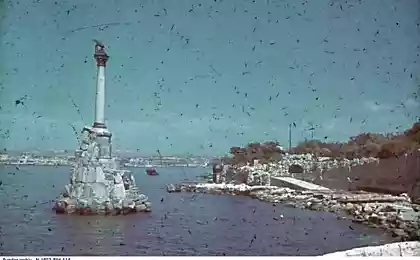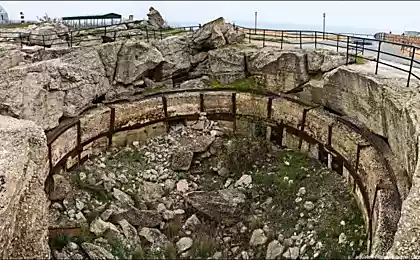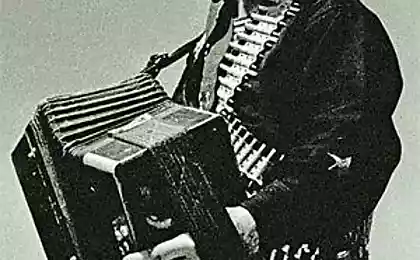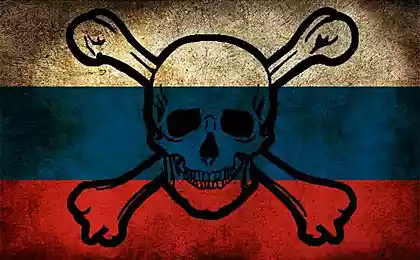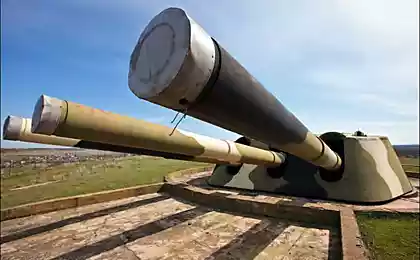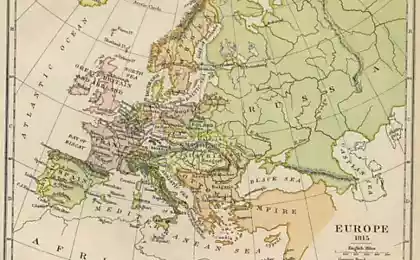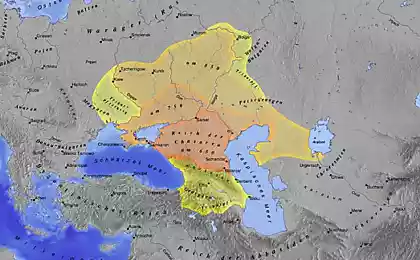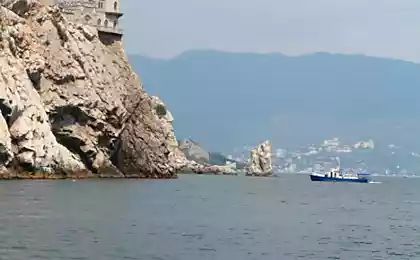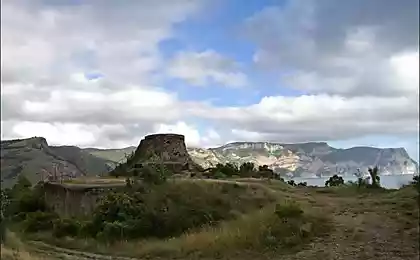1075
2nd defense of Sevastopol
Defense of Sevastopol in the Great Patriotic War of October 5, 1941, German troops (commanded by General von Manstein) broke through the Soviet defenses on Ishun positions and broke into the Crimea. In order to practice the entire peninsula was meant 7 German infantry divisions and two Romanian teams.
The main part of the Soviet troops (7 infantry and 1 cavalry division, under the command of Lieutenant General Batova) became rapidly retreat towards Kerch, vainly pursued by the German 3rd Infantry Division. These Soviet troops in mid-November 1941 crossed the Kerch Strait in the Kuban.
A smaller part of the Soviet troops (4 shooting and 3 cavalry divisions, under the command of Major-General I.E.Petrova) went to Sevastopol, but not in a straight line, and the first in the south-east through the Crimean Mountains in the Alushta and then the coastal road Yalta through the west. This group Petrova (informally called the Maritime Army) pursued two German infantry divisions.
More 2 German infantry divisions and a mobile detachment of Romanian Colonel Korn (2 cavalry regiments and an artillery regiment) moved directly to Sevastopol (General Petrov led his troops through the Crimean Mountains, not to meet with them).
In Sevastopol, in November 1941, there were about 20 thousand Soviet troops - Marines, rear part, the cadets of military schools, coastal artillery, armored train, air defense units, 80 combat aircraft. On November 5, 1941 began skirmishes between the parts of the Soviet marines and German units advanced on the approaches to Sevastopol (15-20 km from the city).
By 9 November, troops of General Petrov gathered around Sevastopol. The number of Soviet troops in Sevastopol defensive area (GRA) reached 52 thousand.
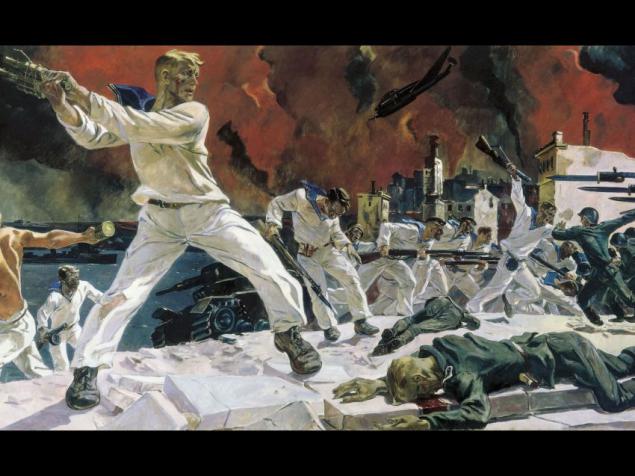
The first German attack on Sevastopol
11-21 November 1941 4 German infantry divisions attacked the Soviet troops on the entire perimeter defense. The Germans were able to move a few kilometers to the southern and eastern areas. The front stabilized at about 12 km from Sevastopol.
From the first days of defense of Sevastopol (1 November 1941), the 30th Battery commanded by Captain G. Alexander led fire on the advancing units to the main base of the fleet of the 11th German Army Colonel General Manstein. June 26th, 1942 the Germans burst into the tower block and captured 40 of his last defenders, all of them were wounded and exhausted from hunger and thirst. After the war, the battery has been restored. Now this place is a part of coastal defense troops of the Black Sea Fleet.
Soviet and German troops occupied the strengthening of its forces. By order of the Supreme Command was sent to Sevastopol Infantry Division and 6,000 soldiers marching replenishment, as well as thousands of rifles, machine guns, ammunition. The Army of the Sevastopol Defense Region in December 1941, consisted of five infantry divisions, two brigades of marines, two separate infantry regiments, tank battalion.
Meanwhile, von Manstein, to be completed by November 16 capture of Crimea (except Sevastopol), left on the Kerch Peninsula only one infantry division and brought the number of German divisions around Sevastopol to six. Romanian Brigade were directed to the bearing of the coastal defense of the Crimea (it is isolated and divisions German divisions, the siege of Sevastopol).
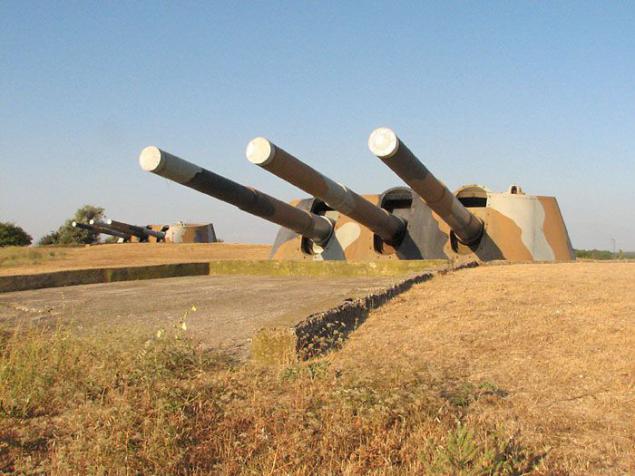
A second German offensive on Sevastopol
Von Manstein planned attack on Sevastopol on November 27 by the German 6th Infantry Division. However, due to heavy rains, snaring, the offensive was only launched 17 December 1941.
During fierce fighting, two German divisions made significant progress in the northern sector.
December 19 commander of the Sevastopol naval base Rear-Admiral Zhukov (Acting Commander COP) has sent a report to the Supreme Commander Stalin:
"The enemy, having concentrated large forces ... for three days leads to violent attacks aim to seize Sevastopol.
Loss of two days of battle reaches 3,000 wounded, many losses in the command personnel.
Large losses of materiel, weapons, machine guns, mortars.
Most of the heavy batteries of coastal defense suppressed.
The troops of almost the entire front put on the line.
Reserves spent replenishment. Shells most desired caliber - 107 mm enclosure, 122 mm howitzer and 82-mm mortar there.
The rest of the ammunition is running out.
On December 20 in order to strengthen parts operating at the front, are entered in the fighting personnel of the ships, coastal batteries, anti-aircraft artillery, airport services, etc.
[If] the enemy attacks continue at the same pace garrison of Sevastopol will not last more than three dney.Krayne need the support of a single CD, aviation companies of the completion of marching, special delivery right caliber ammunition. »
However, contrary to the predictions of Admiral Zhukov Sevastopol defensive area lasted for more than three days. On December 21, Sevastopol Marine Brigade arrived and delivered ammunition for artillery. December 23 arrived Infantry Division and a separate tank battalion (tanks T-26).
The German forces in two weeks of fighting in the northern sector moved 8-10 km (there was breached not only the main line of defense, but also the rear line), on the rest of the Germans advanced on 1-3 km.
Due to the heavy losses the German advance was stopped on December 31, 1941. Also on December 26, the Soviet troops had landed in the eastern part of the Crimea, and von Manstein was forced to send two of the six German divisions besieging Sevastopol.
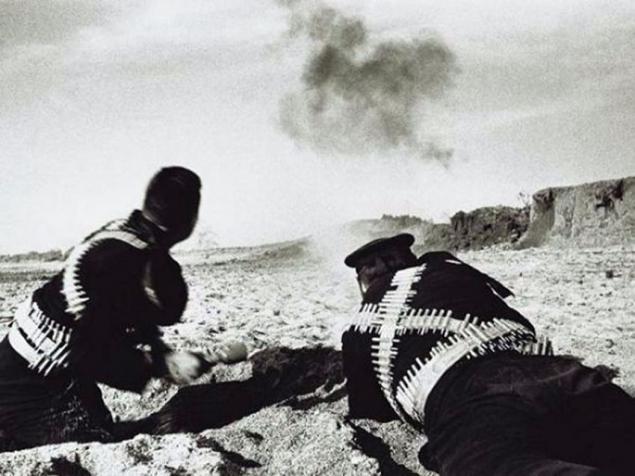
In early January 1942 von Manstein sent to the east of the Crimea another German infantry divisions, leaving the siege of Sevastopol, only three German infantry divisions. At the same time in Sevastopol came another Soviet Infantry Division.
At the end of June 1942 the situation became critical defenders of Sevastopol - the city was not deterred. June 26th through the German naval blockade of Sevastopol broke through the last of the large surface ships - destroyers leader "Tashkent". The ship took on board more than 2,100 people and 86 surviving fragments Roubaud panorama "Defense of Sevastopol in 1854-1855." And at night June 27, 1942 left the Sevastopol.
Starting from 5:00 am to 9:00 June 27, 1942 the leader of the group reflected 86 raid of enemy bombers. Nazi planes dropped 336 bombs on the ship. Through skillful maneuvering managed to avoid direct hits (only one 250 kg bomb struck a glancing blow in the area of the left anchor, but did not explode and drowned), but from close gaps ship received many injuries, some evacuees died.
At 20.15 June 27, 1942 damaged "Tashkent" tug arrived at the entrance to the harbor of Novorossiysk.
In January-May 1942 arrived in Sevastopol almost 12 thousand marching replenishment and Marine Brigade.
May 31, 1942 as part of the Army was COP 7 infantry divisions, 4 Marine Brigade, 2 separate regiment of marines, two tank battalions (38 tanks). Total combatant, taking into account the artillery (field, Coast, flak - 606 guns) and aircraft (109 planes) - 82 thousand people. Given rear units - 106 000.
Third, the German offensive on Sevastopol
After the liquidation of a May 18, 1942 the Soviet troops in the east of the Crimea, von Manstein concentrated for the capture of Sevastopol ("Operation Sturgeon Fishing") 7 German infantry divisions and two Romanian divisions. The total number of body parts, taking into account - up to 150 thousand people. German divisions were attached to the 3rd Battalion, self-propelled guns Stug (von Manstein's tanks in battles for Sevastopol never been there).
Instead of tanks, the German High Command gave von Manstein for the assault of Sevastopol a large number of heavy artillery, including several batteries caliber 305, 350, 420 mm and two 600 mm caliber mortars, and one gun caliber 800 mm.
Available von Manstein was also Air Corps.
June 2, 1942, German artillery and aircraft began attacking the positions of Soviet troops near Sevastopol.
June 7 German divisions launched an offensive on the northern and southern section. Romanian division were distracting fighting in the eastern sector.
By June 17, the German troops almost captured the northern sector of defense of Sevastopol, and made significant progress in the southern sector. During this period in Sevastopol profits Marching Infantry Brigade and the completion, in the amount of about 10 thousand people, but the loss of troops COP at the same time amounted to more than 20,000 wounded, missing and dead.
On June 24, the latest addition to the GRA arrived - Infantry Brigade.
June 29, 1942, German troops entered Sevastopol
In January-February 1942, Soviet and German troops near Sevastopol fought local significance.
February 27, 1942 on the orders of the Supreme Command troops COP launched an offensive in the northern sector, to support the actions of the Soviet troops in the east of the Crimea. Intense fighting continued for 5 days, until March 3.
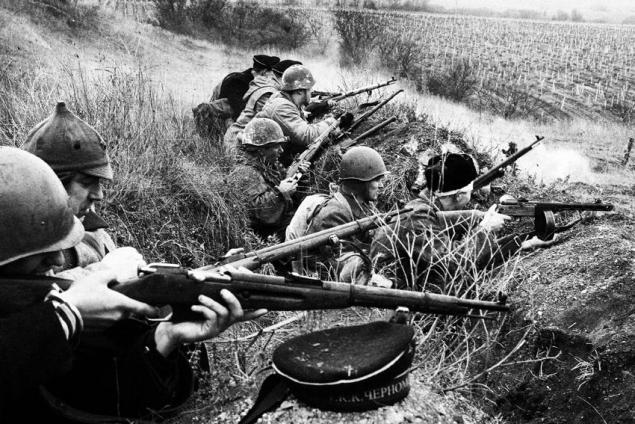
From the report of the Political Administration of the Black Sea Fleet on July 22, 1942 on the outcome of the June fighting and evacuation of Sevastopol:
"The most intense period, when large groups of enemy tanks broke through from the area of the farm Kalfa and Nikolayevka, most of the tools of coastal defense was broken, broken through the main blow to the group caused the battery №35, which since June 30, 1942 was the most recent stable node resistance the approaches to Chersonesos peninsula. Personnel have approached the parts under the cover of the battery last three days beat off numerous enemy attacks, providing sea and air evacuation. Having shot full of ammunition and firing up to 50 practice projectile 35th battery during the night of 1 July 2 was blown ».
June 30, 1942 (at 7 am), the commander of the COP Vice-Admiral Oktyabrsky sent a report to the commander of the North Caucasian Front Marshal Budyonny:
"The enemy broke into the north side on the ship's side.
Fighting assume the character of street fighting.
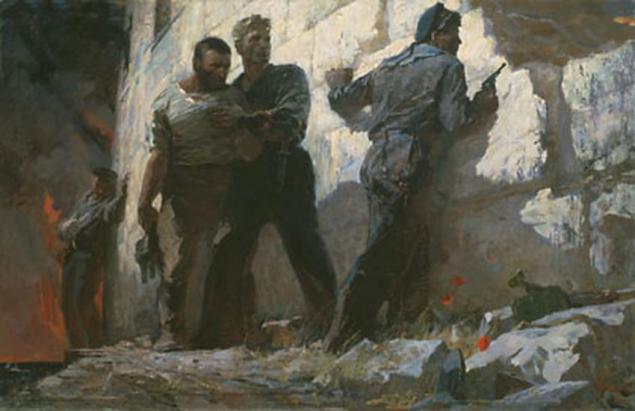
The Germans did not manage to suppress our batteries either artillery fire or by aircraft. July 1, 1942, the 35th Battery issued last 6 rounds point-blank range by the advancing enemy infantry, and on the night of July 2, the battery commander Captain Leshchenko organized undermining of the battery.
Resistance remains of Soviet troops at Cape Chersonese lasted until July 4, 1942. The evacuation was not carried out. As a result, the German prisoner was taken more than 80 thousand soldiers and commanders of the Red Army and Red Navy (for the third time the German offensive on Sevastopol).
Altogether during the defense of Sevastopol (from November 1941 to July 1942), Soviet prisoners of war and loss of life amounted to 156.880 persons (according to Colonel-General Krivosheev).
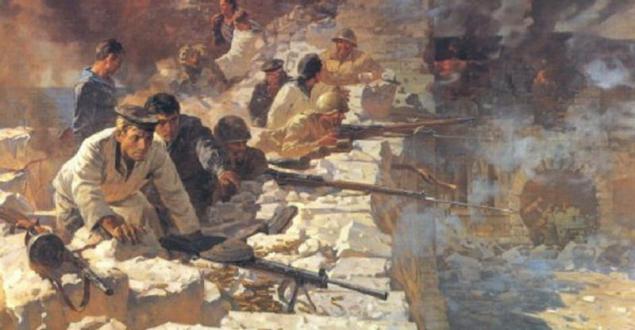
dud propelled mortars Karl - 600 mm
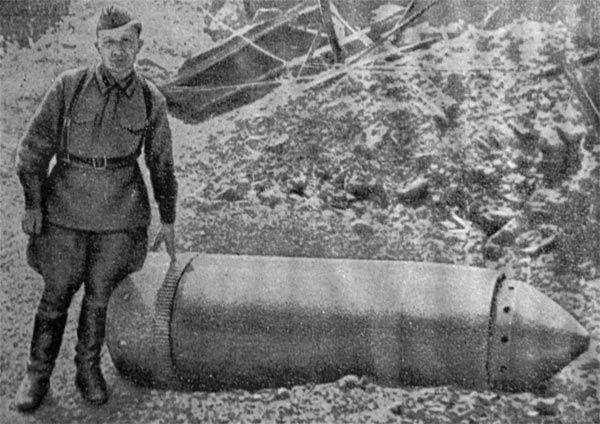
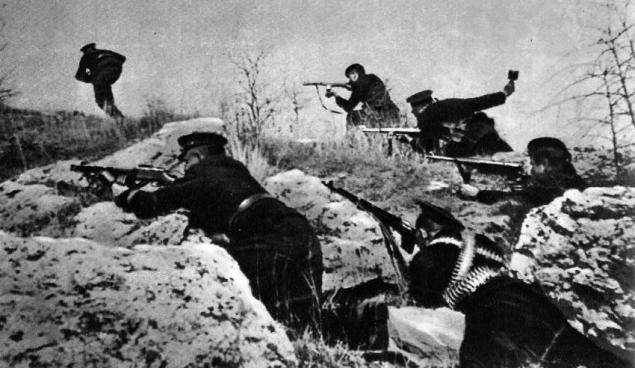
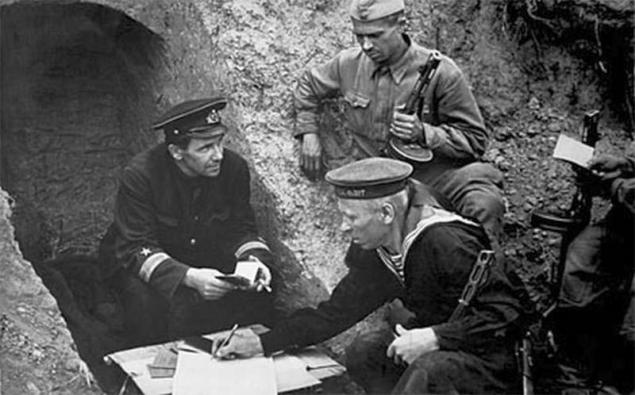
legendary female sniper Lyudmila Pavlichenko in battles for Crimea
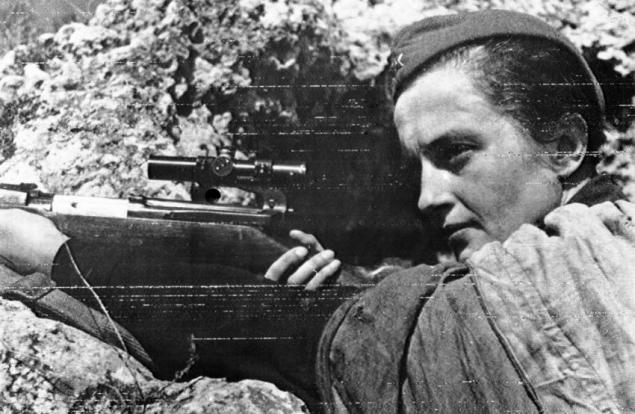
Marines in the battle for Sevastopol
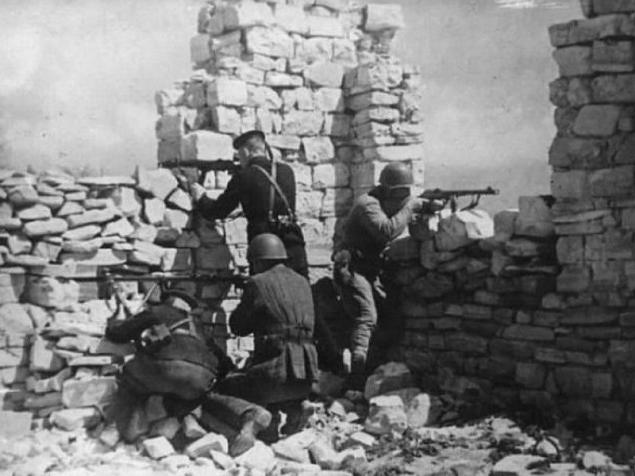
Altogether during the defense of Sevastopol (from November 1941 to July 1942), Soviet prisoners of war and loss of life amounted to 156.880 persons (according to Colonel-General Krivosheev).
Battle of Sevastopol in June-July 1942 affected the whole course of the summer-autumn campaign of 1942 in the southern wing of the Soviet-German front, which ended ultimately defeat the Germans at Stalingrad and fracture the whole course of events of the Second World War.
The third assault on Sevastopol June 2-July 12, 1942 was not an ordinary military operation. THE NUMBERS:
If you take the balance of forces on the German Army Group "South" with its 1,000 kilometers of the front, in the face of his army of 11, she has focused on the 40 km front at Sevastopol 25% personnel, 30% of aviation, 11% artillery.
Sevastopol was 80% of the super-heavy artillery of the German army as a private and svezennoy from all the occupied countries of Europe (300 barrels) caliber 240, 280, 305, 355, 420, 615 and 810 mm (gun "Dora"). The remaining 20% were in Leningrad.
The German air force during the capture of Sebastopol has committed 23751 sorties and dropped 20, 6 thous. Tons of bombs (125 thousand. Bombs of different caliber) or as much as the British aircraft dropped to the whole of Germany in the years 1939-1942
During 250 days of siege the German army lost 11 killed, died of wounds and died from accidents and accidents to 60 thousand. And 240 thousand people. Made sanitary losses. This is the same as all the German armed forces have lost in the capture of Western Europe and the Balkans in the period from September 1, 1939 to May 15, 1941.
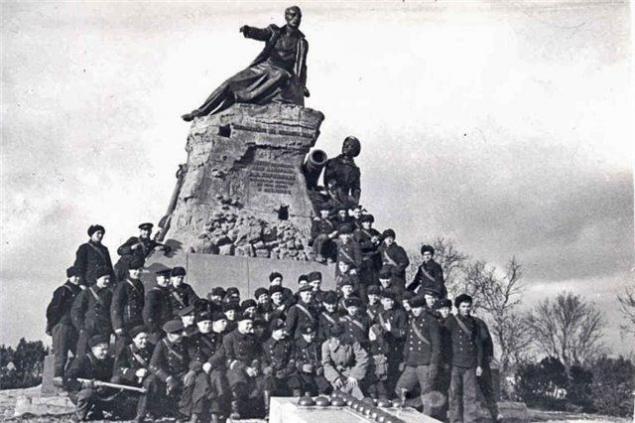
Eternal glory and the eternal memory of the heroes!
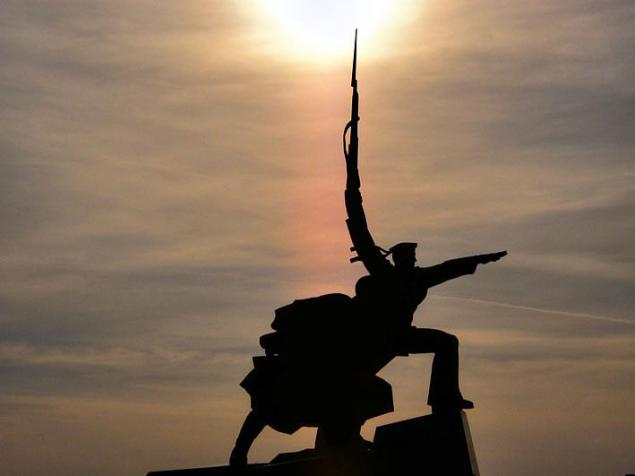

Source:
The main part of the Soviet troops (7 infantry and 1 cavalry division, under the command of Lieutenant General Batova) became rapidly retreat towards Kerch, vainly pursued by the German 3rd Infantry Division. These Soviet troops in mid-November 1941 crossed the Kerch Strait in the Kuban.
A smaller part of the Soviet troops (4 shooting and 3 cavalry divisions, under the command of Major-General I.E.Petrova) went to Sevastopol, but not in a straight line, and the first in the south-east through the Crimean Mountains in the Alushta and then the coastal road Yalta through the west. This group Petrova (informally called the Maritime Army) pursued two German infantry divisions.
More 2 German infantry divisions and a mobile detachment of Romanian Colonel Korn (2 cavalry regiments and an artillery regiment) moved directly to Sevastopol (General Petrov led his troops through the Crimean Mountains, not to meet with them).
In Sevastopol, in November 1941, there were about 20 thousand Soviet troops - Marines, rear part, the cadets of military schools, coastal artillery, armored train, air defense units, 80 combat aircraft. On November 5, 1941 began skirmishes between the parts of the Soviet marines and German units advanced on the approaches to Sevastopol (15-20 km from the city).
By 9 November, troops of General Petrov gathered around Sevastopol. The number of Soviet troops in Sevastopol defensive area (GRA) reached 52 thousand.

The first German attack on Sevastopol
11-21 November 1941 4 German infantry divisions attacked the Soviet troops on the entire perimeter defense. The Germans were able to move a few kilometers to the southern and eastern areas. The front stabilized at about 12 km from Sevastopol.
From the first days of defense of Sevastopol (1 November 1941), the 30th Battery commanded by Captain G. Alexander led fire on the advancing units to the main base of the fleet of the 11th German Army Colonel General Manstein. June 26th, 1942 the Germans burst into the tower block and captured 40 of his last defenders, all of them were wounded and exhausted from hunger and thirst. After the war, the battery has been restored. Now this place is a part of coastal defense troops of the Black Sea Fleet.
Soviet and German troops occupied the strengthening of its forces. By order of the Supreme Command was sent to Sevastopol Infantry Division and 6,000 soldiers marching replenishment, as well as thousands of rifles, machine guns, ammunition. The Army of the Sevastopol Defense Region in December 1941, consisted of five infantry divisions, two brigades of marines, two separate infantry regiments, tank battalion.
Meanwhile, von Manstein, to be completed by November 16 capture of Crimea (except Sevastopol), left on the Kerch Peninsula only one infantry division and brought the number of German divisions around Sevastopol to six. Romanian Brigade were directed to the bearing of the coastal defense of the Crimea (it is isolated and divisions German divisions, the siege of Sevastopol).

A second German offensive on Sevastopol
Von Manstein planned attack on Sevastopol on November 27 by the German 6th Infantry Division. However, due to heavy rains, snaring, the offensive was only launched 17 December 1941.
During fierce fighting, two German divisions made significant progress in the northern sector.
December 19 commander of the Sevastopol naval base Rear-Admiral Zhukov (Acting Commander COP) has sent a report to the Supreme Commander Stalin:
"The enemy, having concentrated large forces ... for three days leads to violent attacks aim to seize Sevastopol.
Loss of two days of battle reaches 3,000 wounded, many losses in the command personnel.
Large losses of materiel, weapons, machine guns, mortars.
Most of the heavy batteries of coastal defense suppressed.
The troops of almost the entire front put on the line.
Reserves spent replenishment. Shells most desired caliber - 107 mm enclosure, 122 mm howitzer and 82-mm mortar there.
The rest of the ammunition is running out.
On December 20 in order to strengthen parts operating at the front, are entered in the fighting personnel of the ships, coastal batteries, anti-aircraft artillery, airport services, etc.
[If] the enemy attacks continue at the same pace garrison of Sevastopol will not last more than three dney.Krayne need the support of a single CD, aviation companies of the completion of marching, special delivery right caliber ammunition. »
However, contrary to the predictions of Admiral Zhukov Sevastopol defensive area lasted for more than three days. On December 21, Sevastopol Marine Brigade arrived and delivered ammunition for artillery. December 23 arrived Infantry Division and a separate tank battalion (tanks T-26).
The German forces in two weeks of fighting in the northern sector moved 8-10 km (there was breached not only the main line of defense, but also the rear line), on the rest of the Germans advanced on 1-3 km.
Due to the heavy losses the German advance was stopped on December 31, 1941. Also on December 26, the Soviet troops had landed in the eastern part of the Crimea, and von Manstein was forced to send two of the six German divisions besieging Sevastopol.

In early January 1942 von Manstein sent to the east of the Crimea another German infantry divisions, leaving the siege of Sevastopol, only three German infantry divisions. At the same time in Sevastopol came another Soviet Infantry Division.
At the end of June 1942 the situation became critical defenders of Sevastopol - the city was not deterred. June 26th through the German naval blockade of Sevastopol broke through the last of the large surface ships - destroyers leader "Tashkent". The ship took on board more than 2,100 people and 86 surviving fragments Roubaud panorama "Defense of Sevastopol in 1854-1855." And at night June 27, 1942 left the Sevastopol.
Starting from 5:00 am to 9:00 June 27, 1942 the leader of the group reflected 86 raid of enemy bombers. Nazi planes dropped 336 bombs on the ship. Through skillful maneuvering managed to avoid direct hits (only one 250 kg bomb struck a glancing blow in the area of the left anchor, but did not explode and drowned), but from close gaps ship received many injuries, some evacuees died.
At 20.15 June 27, 1942 damaged "Tashkent" tug arrived at the entrance to the harbor of Novorossiysk.
In January-May 1942 arrived in Sevastopol almost 12 thousand marching replenishment and Marine Brigade.
May 31, 1942 as part of the Army was COP 7 infantry divisions, 4 Marine Brigade, 2 separate regiment of marines, two tank battalions (38 tanks). Total combatant, taking into account the artillery (field, Coast, flak - 606 guns) and aircraft (109 planes) - 82 thousand people. Given rear units - 106 000.
Third, the German offensive on Sevastopol
After the liquidation of a May 18, 1942 the Soviet troops in the east of the Crimea, von Manstein concentrated for the capture of Sevastopol ("Operation Sturgeon Fishing") 7 German infantry divisions and two Romanian divisions. The total number of body parts, taking into account - up to 150 thousand people. German divisions were attached to the 3rd Battalion, self-propelled guns Stug (von Manstein's tanks in battles for Sevastopol never been there).
Instead of tanks, the German High Command gave von Manstein for the assault of Sevastopol a large number of heavy artillery, including several batteries caliber 305, 350, 420 mm and two 600 mm caliber mortars, and one gun caliber 800 mm.
Available von Manstein was also Air Corps.
June 2, 1942, German artillery and aircraft began attacking the positions of Soviet troops near Sevastopol.
June 7 German divisions launched an offensive on the northern and southern section. Romanian division were distracting fighting in the eastern sector.
By June 17, the German troops almost captured the northern sector of defense of Sevastopol, and made significant progress in the southern sector. During this period in Sevastopol profits Marching Infantry Brigade and the completion, in the amount of about 10 thousand people, but the loss of troops COP at the same time amounted to more than 20,000 wounded, missing and dead.
On June 24, the latest addition to the GRA arrived - Infantry Brigade.
June 29, 1942, German troops entered Sevastopol
In January-February 1942, Soviet and German troops near Sevastopol fought local significance.
February 27, 1942 on the orders of the Supreme Command troops COP launched an offensive in the northern sector, to support the actions of the Soviet troops in the east of the Crimea. Intense fighting continued for 5 days, until March 3.

From the report of the Political Administration of the Black Sea Fleet on July 22, 1942 on the outcome of the June fighting and evacuation of Sevastopol:
"The most intense period, when large groups of enemy tanks broke through from the area of the farm Kalfa and Nikolayevka, most of the tools of coastal defense was broken, broken through the main blow to the group caused the battery №35, which since June 30, 1942 was the most recent stable node resistance the approaches to Chersonesos peninsula. Personnel have approached the parts under the cover of the battery last three days beat off numerous enemy attacks, providing sea and air evacuation. Having shot full of ammunition and firing up to 50 practice projectile 35th battery during the night of 1 July 2 was blown ».
June 30, 1942 (at 7 am), the commander of the COP Vice-Admiral Oktyabrsky sent a report to the commander of the North Caucasian Front Marshal Budyonny:
"The enemy broke into the north side on the ship's side.
Fighting assume the character of street fighting.

The Germans did not manage to suppress our batteries either artillery fire or by aircraft. July 1, 1942, the 35th Battery issued last 6 rounds point-blank range by the advancing enemy infantry, and on the night of July 2, the battery commander Captain Leshchenko organized undermining of the battery.
Resistance remains of Soviet troops at Cape Chersonese lasted until July 4, 1942. The evacuation was not carried out. As a result, the German prisoner was taken more than 80 thousand soldiers and commanders of the Red Army and Red Navy (for the third time the German offensive on Sevastopol).
Altogether during the defense of Sevastopol (from November 1941 to July 1942), Soviet prisoners of war and loss of life amounted to 156.880 persons (according to Colonel-General Krivosheev).

dud propelled mortars Karl - 600 mm



legendary female sniper Lyudmila Pavlichenko in battles for Crimea

Marines in the battle for Sevastopol

Altogether during the defense of Sevastopol (from November 1941 to July 1942), Soviet prisoners of war and loss of life amounted to 156.880 persons (according to Colonel-General Krivosheev).
Battle of Sevastopol in June-July 1942 affected the whole course of the summer-autumn campaign of 1942 in the southern wing of the Soviet-German front, which ended ultimately defeat the Germans at Stalingrad and fracture the whole course of events of the Second World War.
The third assault on Sevastopol June 2-July 12, 1942 was not an ordinary military operation. THE NUMBERS:
If you take the balance of forces on the German Army Group "South" with its 1,000 kilometers of the front, in the face of his army of 11, she has focused on the 40 km front at Sevastopol 25% personnel, 30% of aviation, 11% artillery.
Sevastopol was 80% of the super-heavy artillery of the German army as a private and svezennoy from all the occupied countries of Europe (300 barrels) caliber 240, 280, 305, 355, 420, 615 and 810 mm (gun "Dora"). The remaining 20% were in Leningrad.
The German air force during the capture of Sebastopol has committed 23751 sorties and dropped 20, 6 thous. Tons of bombs (125 thousand. Bombs of different caliber) or as much as the British aircraft dropped to the whole of Germany in the years 1939-1942
During 250 days of siege the German army lost 11 killed, died of wounds and died from accidents and accidents to 60 thousand. And 240 thousand people. Made sanitary losses. This is the same as all the German armed forces have lost in the capture of Western Europe and the Balkans in the period from September 1, 1939 to May 15, 1941.

Eternal glory and the eternal memory of the heroes!


Source:
Mordovia former member pussy riot newly upholstered zelenkoj
Reasons for deciding to take place at the window

